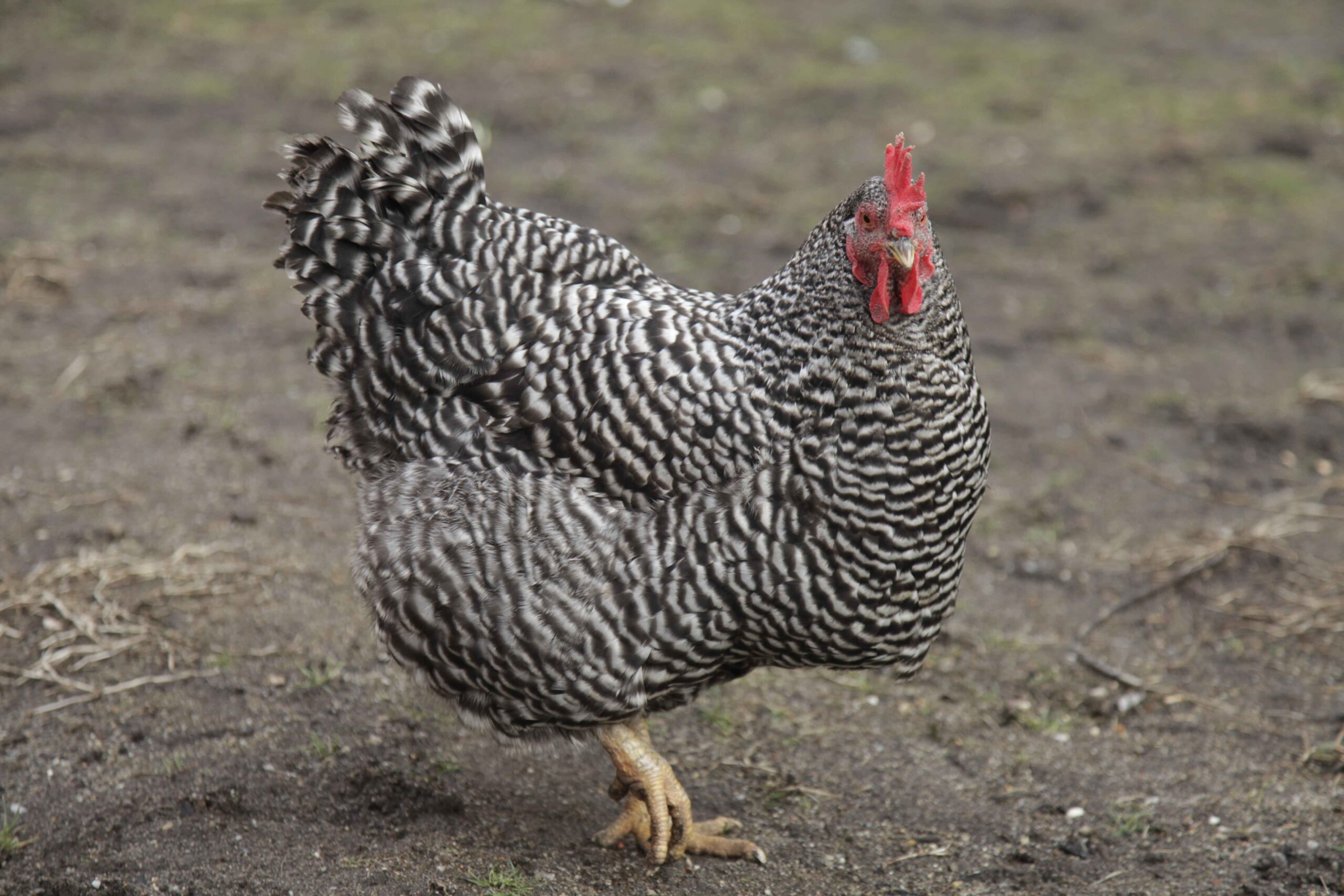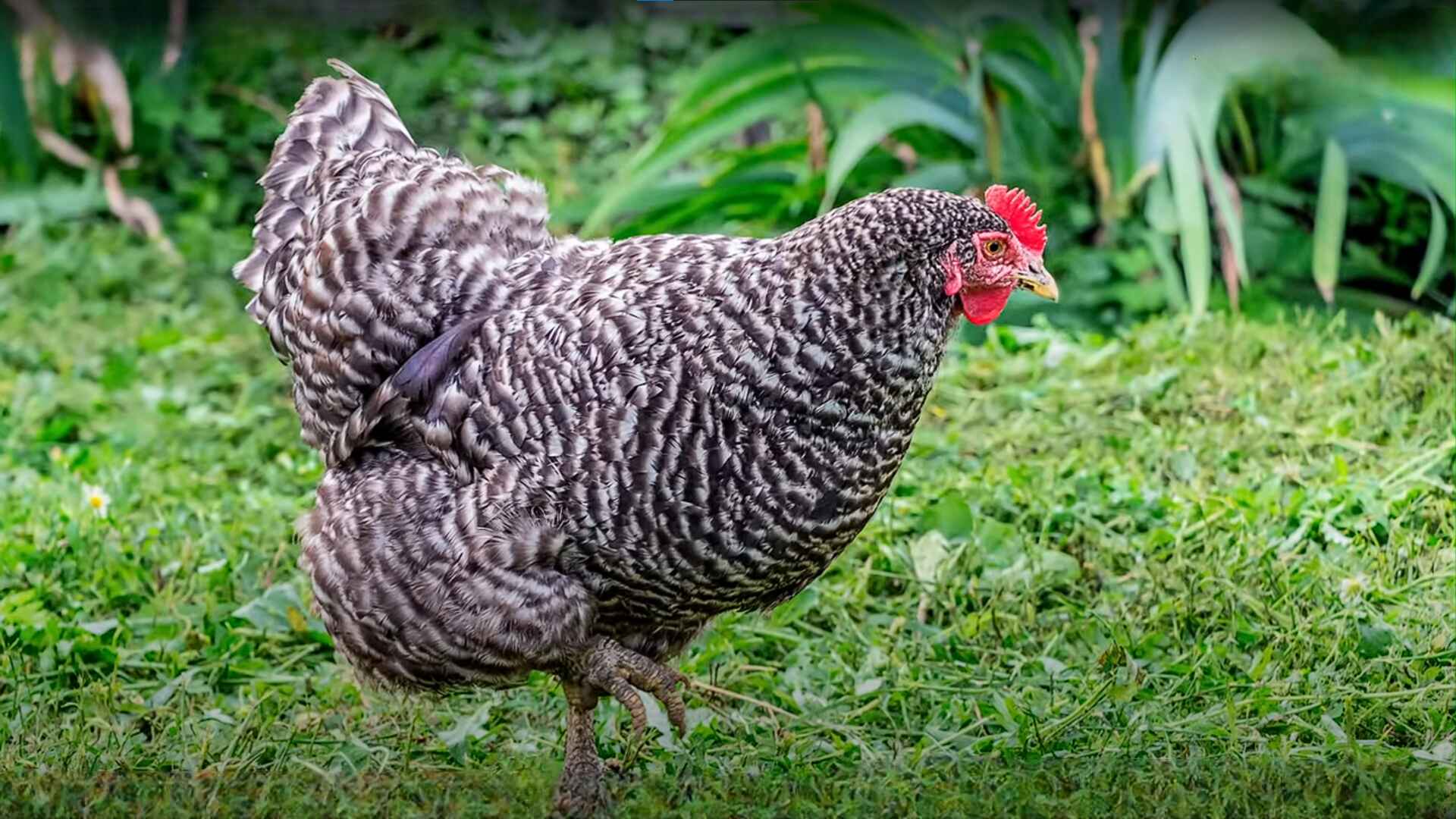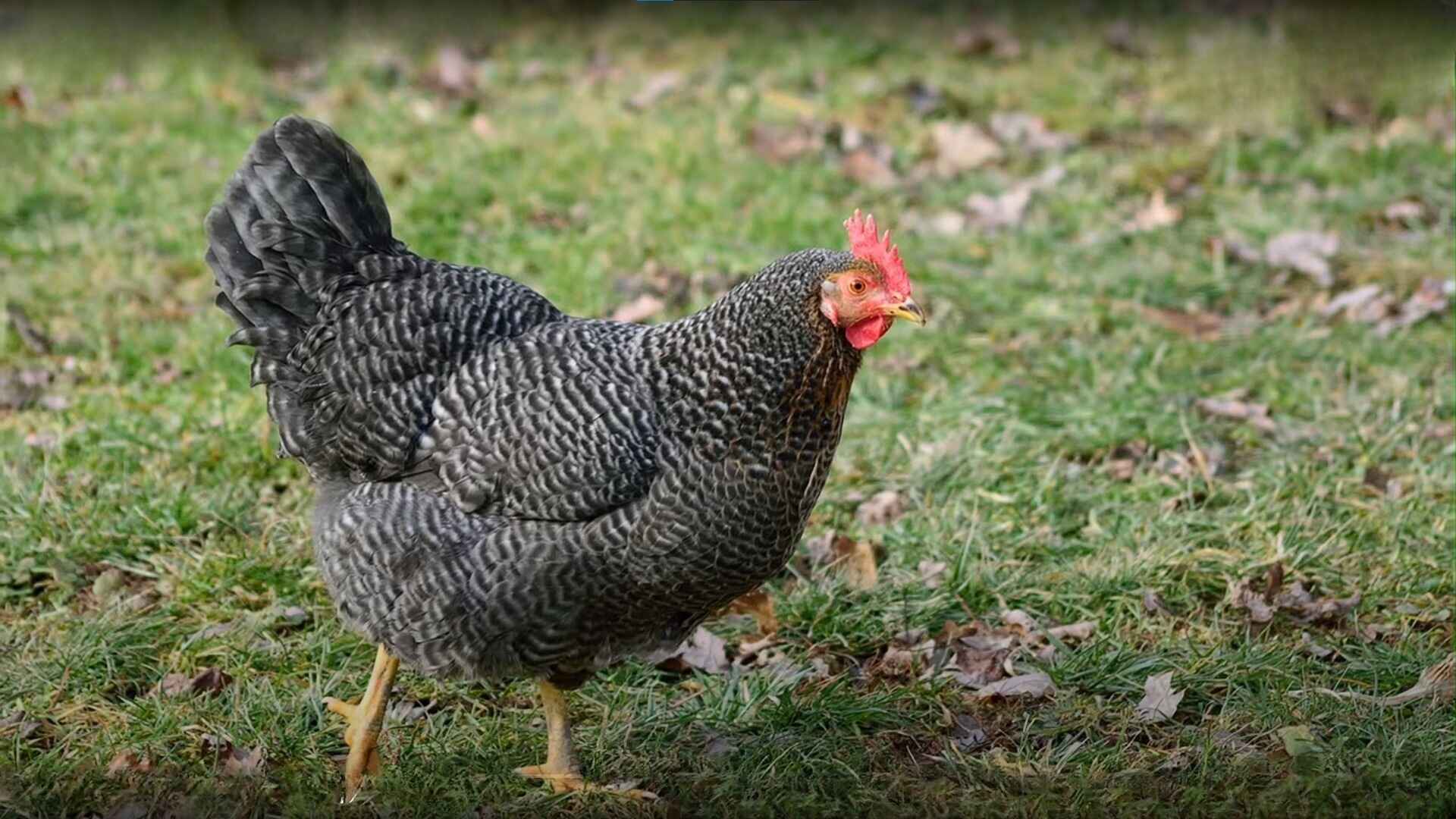When it comes to keeping chickens, the Barred Rock is an ideal choice for beginners. These hardy birds are known for their friendly personality and dependable nature, making them a popular option among homesteaders. With its striking black-and-white feathers, the Barred Plymouth Rock stands out as a beautiful addition to any backyard flock.
Not only are they excellent egg-laying hens, but their dual-purpose traits make them great for meat production as well. Over the years, these incredible birds have proven themselves to be healthy and low-maintenance, requiring minimal care while providing consistent results.
My first experience with these amazing birds was unforgettable. Watching the fluffy chicks grow into full-grown hens was both rewarding and educational. Their easy-going and personable nature made them a hit, they loved snuggling the littles and feeding them from the palm of their hands.
These absolute favorites are often seen as the backbone of homesteads, as their versatility and adaptability make them suitable for various climates and conditions. Whether you’re starting your flock or expanding, the Barred Rock is an excellent choice for its dependable, long-lasting traits.

Table of Contents
ToggleQuick Overview: Plymouth Barred Rock Chicken
The Plymouth Barred Rock is a friendly, hardy, and dual-purpose chicken breed, ideal for beginners and homesteaders alike. Known for their striking black-and-white feathers, calm temperament, and reliable egg production of around 200 brown eggs annually, these birds are adaptable to various climates and require minimal care.
Developed in 19th-century New England, Barred Rocks are larger in size, excellent mothers, and can live up to 8–10 years with good care. They are cold- and heat-tolerant, a bit noisy, and suitable for meat production due to their quick maturity and flavorful meat, making them a dependable and versatile addition to any flock.
The History of Barred Rock Chickens
The Barred Rock has a rich history that dates back to the early 19th century in New England. Known for their barred feathers and hardy nature, they first gained attention at a poultry show in Boston in 1849. This breed was developed by crossing Dominique chickens with Black Javas, resulting in a bird with a distinct color pattern and a balance of being both a reliable egg layer and a large bird for meat production.
Officially recognized as a standard breed by the American Poultry Association in 1869, the Plymouth Rock quickly became a favorite among farmers thanks to its adaptability to colder climates and dual-purpose utility.
Often nicknamed America’s favorite breed, the Barred Rock is celebrated for being productive, friendly, and easy to raise. With its eight variations, it stands out as one of America’s beloved chickens. By the mid-1800s, it earned the title of the “Hereford of poultry” for its versatility and popularity.
Whether for its dependable egg-laying or ability to produce meat, this breed has become a staple in backyards across the country. Its combination of historical significance and practical traits has cemented its place as a top choice for both beginners and experienced poultry keepers.
Breed Characteristics
The Barred Plymouth Rock is a recognizable breed with a distinct appearance. Their black-and-white barred feathers and single comb make them stand out, while their clean feet with four toes contribute to their neat look. Hens typically weigh 7-8 pounds, and roosters reach 9-10 pounds,
making them a larger breed. They adapt well to any environment, whether they’re allowed to free-range or kept in a run. Their hardy nature and adaptable personality make them a perfect fit for any setup.
These chickens share a resemblance to Cuckoo Marans, often leading to misidentification. However, key differences, such as their floppy combs, which flop to one side instead of standing upright, and their pronounced white feathers, help with proper identification.
Common features of the Barred Rock include a large single comb, bright red wattles, and bare legs. Their fluffy feathers, coupled with their docile temperament, make them a delight to raise. Whether you’re interested in their meat or egg production, their dual-purpose traits make them an exceptional choice for beginners and seasoned poultry enthusiasts alike.
Barred Rock Chicken Temperament
The Plymouth Barred Rocks are known for their sweet and gentle nature, making them an excellent choice for families with children. Their calm and mellow disposition allows them to form strong attachments to their owners, often happily following them around the yard.
While these chickens are generally friendly and docile, they can also be quite vigilant when around strangers. Unlike some breeds, their communication consists of soft coos rather than harsh clucks, making them a great fit for urban settings. Despite their protective tendencies, they are not aggressive, though they hold their own in the pecking order.
Our Barred Rock hens have proven to be the “Queens of the Coop” in every sense. Their dominance means they occasionally get a bit aggressive toward new chickens introduced to the coop. For instance, they’ve been known to chase a rooster if they feel he’s hurting a hen during mating.
However, their generally easygoing nature makes them easier to handle compared to other breeds like Golden Comets. Their balance of strength and calmness ensures they remain a reliable and lovable addition to any flock.

Egg Production
Barred Plymouth Rocks are reliable when it comes to egg production, starting as early as 18 weeks to 20 weeks old (about 4.5 to 5 months). In their first year, you can expect around 200 eggs with proper care and a good diet. These brown eggs are often large, and the hens can lay 4+ eggs per week, making them great for steady production.
While their productivity does decline by 10-15% per year as they age, they remain a solid choice for backyard flocks. Some heritage chickens can even lay for up to ten years, though their egg production will naturally slow after their third or fourth year.
Compared to other breeds like Isa Browns, Barred Rocks may produce slightly less eggs, but they are known for their hardy nature and ability to lay year-round, even in winter.
There are two distinct strains of production Barred Rocks, which can lay up to 250 eggs per year but taper off after about two to three years, and heritage Barred Rocks, which produce fewer eggs annually but continue to lay well into their later years.
With their friendly and docile temperament, these dual-purpose chickens are not just great for eggs but also a joy to have in any flock.
Egg Color
Barred Rock chickens are known for laying brown eggs with a beautiful range of shades. Their eggs are typically medium to large in size, with a light to medium brown shell color that sometimes takes on a pinkish hue. These subtle variations in egg appearance make them not only practical but also visually appealing for backyard enthusiasts.
Broodiness
Barred Rocks are admired for their maternal instinct, often displaying broody tendencies that make them great mothers. Their fluffy feathers provide warmth and comfort, allowing them to sit on eggs and provide excellent care for their chicks.
Not all Barred Rock hens will show broodiness, making them equally valued as excellent layers for those who want consistent egg production without the challenge of dealing with a broody hen.
With the right environment and a few eggs left in the nest, this instinct can sometimes be encouraged, making Barred Rocks a versatile addition to any flock.
Are Barred Rock Chickens Good For Meat Production?
Barred Rocks are a great choice for meat production, especially if you’re looking for a larger breed that matures quickly. As one of the foundations of the American broiler chicken industry, they reach broiler size in just 8 to 12 weeks. Unlike some other breeds, they require less feed to reach their maximum size, making them an efficient option.
While Barred Rocks produce more dark meat than breeds like the Cornish Cross, they have less breast meat, which might be a consideration depending on your preferences. Once processed, their meat is known for being juicy and tender, a quality that sets them apart as excellent meat birds for both small farms and larger operations.

Are Barred Rock Chickens a Heritage or Hybrid Breed?
Barred Rocks are recognized as one of America’s oldest heritage breeds, with a lineage that dates back to the early 1800’s. These chickens are celebrated for their historical significance and are recognized by the American Poultry Association.
There are 8 varieties, including Barred, Black (bantam only), Blue, Buff, Partridge, Silver Penciled, Columbian, and White. Their heritage status highlights their traditional breeding and importance in American poultry history.
How Much Does The Average Barred Rock Chicken Weigh?
Barred Rocks are considered a larger breed of chickens, with roosters weighing around 9.5 pounds on average and hens closer to 7.5 pounds. Compared to an average-sized rooster of 6 pounds and a hen at 5.7 pounds, Barred Rocks are noticeably bigger. Their fluffy feathers also give them the appearance of being even larger, which adds to their charm as large birds.
In our experience, Barred Rocks tend to be of similar size to other breeds like Columbian Wyandotte’s, which are also cold-tolerant and hardy. Their size and resilience make them an excellent choice for various climates, and their impressive stature sets them apart from many other chickens.
Average Lifespan For Barred Rock Chicken Breed
Barred Rock chickens are known for their above-average lifespan, typically living between 6 to 8 years when kept in backyard confinement. This is longer than the average lifespan of most chickens, which ranges from 3 to 7 years. In optimal conditions, their life expectancy can extend to an impressive 10 to 12 years, showcasing their resilience and adaptability with proper care.
However, when raised as meat birds, their lifespan is often much shorter, averaging only 2 to 3 years due to decreased production as they age. This dual-purpose breed offers flexibility for those looking for either long-term flock members or birds for utility purposes, making Barred Rocks a practical choice for many chicken keepers.
Are Barred Rock Chickens Hardy?
Barred Rock chickens are well-known for their hardiness, making them a fantastic choice for anyone interested in raising chickens. These cold hardy birds are built to thrive in the extreme weather conditions of New England. Their fluffy feathers help retain body heat during the winter, while their featherless legs reduce issues with dampness.
Even in hot, sunny weather, their large wattles and floppy combs allow heat to circulate and cool them down, making them equally heat tolerant.
To keep these backyard chickens comfortable year-round, ensure they have proper shelter with a dry, warm space in the winter and shade in the summer. It’s also important to provide plenty of water and watch for frostbite on their combs, feet, or wattles during extreme cold.
Their well-rounded nature and adaptability mean they rarely cause drama in the coop, making them an easy-to-handle and reliable addition to any flock.
Are Barred Rock Chickens Noisy?
Barred Rocks are known to be an above-average breed when it comes to noise levels. Their hens often produce an abundance of noise, and the roosters are known to consistently crow, making them unsuitable for densely populated areas or urban farms.
In our experience, even several Barred Rocks together tend to be constantly vocal, sometimes even louder than breeds like Leghorns, which are famously noisy. For quieter surroundings, they are better suited for rural farms, where their energetic nature and sounds are less disruptive. Whether they are broody or simply walking around the run, their behavior tends to lean toward the noisier side.

Common Barred Rock Chicken Health Issues
Barred Rocks are typically healthy chickens with minimal risk of notable illnesses, but like any flock, they require attention to stay well. Providing vitamins in their water as a precaution can help address potential deficiencies, especially in younger birds still integrating into the flock. A watchful eye on their environment is essential to prevent common problems such as parasites or general illnesses.
The most likely issue for this breed is heat stroke during extreme heat, as their abundance of feathers can make cooling difficult. In the winter, roosters are susceptible to frostbite on their combs, so a clean space and proper shelter are necessary.
Interestingly, White Plymouth Rocks are known to be resistant to diseases like Marek’s, a devastating disease for any flock. Keeping their living conditions optimal ensures they remain healthy year-round.
Barred Rock Chicken Housing Requirements
Barred Rocks, being a large-sized breed, need at least 4 square feet per bird in a secure coop to stay comfortable. The coop should be unheated but protected from predators and limited drafts to ensure their safety. Even in extreme conditions like -22 (negative twenty-two) degrees with wind chill, our Barred Rocks stayed healthy.
For outdoor spaces, an enclosed run with 10 square feet per bird is ideal. During hot sunny weather, a roofed run with plenty of airflow and shady areas keeps the flock happy and healthy. Free access to a cooler coop ensures they remain comfortable, even on days reaching 90 degrees.
Are Barred Rock Chickens Right For You?
If you’re looking for a friendly breed with a docile temperament, Barred Rocks might be the perfect addition to your backyard flock. Known for their adaptability to colder climates and warm climates, they are a great choice for beginners.
These dual-purpose chickens are excellent for those seeking both brown eggs and flavorful dark meat. While not the strongest egg producers, their gentle personality and heat tolerance make them easy to manage and enjoyable to raise. As one of our first chickens, we can confidently recommend them as a suitable option for anyone starting their poultry journey.




